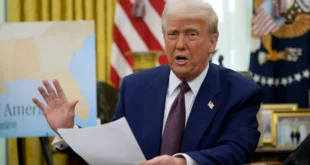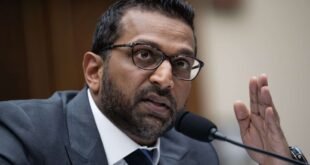It started with a halftime announcement — the kind of thing that usually brings excitement, nostalgia, and endless debates over which artist deserves the stage.
But this time, it sparked something different.
The National Football League had just revealed that the 2026 Super Bowl Halftime Show would be headlined by Bad Bunny, the Puerto Rican global superstar whose career had turned reggaeton into a worldwide phenomenon.
Within hours, social media exploded.
Fans were thrilled. Critics were furious. And before the day was over, the White House had entered the conversation — not with congratulations, but with a warning.
Because this wasn’t just about music anymore.
This was about politics, immigration, identity, and the power of one of the most-watched television events in the world.
“This Is for My People”
Bad Bunny’s announcement video hit like a lightning bolt.
With his trademark cool confidence, he looked straight into the camera and said only eight words:
“This is for my people, my culture, our history.”
The message was brief — and intentional.
It was a celebration of Latin pride, a nod to the millions who had followed his rise from the streets of Vega Baja to global superstardom. But to some in Washington, those words carried a political edge — especially after the artist’s years of outspoken criticism of the U.S. government’s immigration policies.
His tours had famously skipped several U.S. cities. His interviews had touched on deportations, ICE raids, and what he called “a system built to keep people afraid.”
And now, the most polarizing artist in Latin music was about to perform on the most American stage there is.
The Super Bowl.
The Trump Administration Responds
While fans were busy celebrating online, Trump’s longtime adviser Corey Lewandowski sat in a Fox News studio, delivering a very different message.
“There is nowhere you can provide safe haven to people who are in this country illegally,” he said.
“Not the Super Bowl and nowhere else. We will find you, apprehend you, and deport you.”
His words were clear — and stunning.
He wasn’t talking about the performer.
He was talking about the audience.
According to Lewandowski, ICE agents would be deployed at the 2026 Super Bowl in Santa Clara, California — a move that immediately ignited a national debate.
“We are going to do enforcement everywhere,” he said.
“It doesn’t matter if it’s a concert for Johnny Smith or Bad Bunny or anybody else. We’re going to make Americans safe. That is a directive from the president.”
With that, the Trump administration had officially tied one of the world’s biggest entertainment events to one of its toughest immigration crackdowns.
The Divide Widens
It didn’t take long for the reactions to pour in.
Supporters of the move praised Trump’s “law and order consistency,” calling it proof that “no one is above the law.”
Critics, however, accused the White House of weaponizing the Super Bowl to send a political message.
On social media, hashtags like #BoycottTheBowl and #ICEatSuperBowl trended simultaneously.
Celebrities chimed in. Commentators argued. And in the middle of it all, Bad Bunny remained silent — at least publicly.
But his fans didn’t.
“He’s performing for the world,” one user posted on X.
“Why are they trying to make this about immigration?”
“This isn’t a deportation rally,” another wrote. “It’s the Super Bowl.”
Still, Trump’s allies stood firm.
They said the message wasn’t about music — it was about security.
And the president, one adviser said privately, “wants the Super Bowl to represent America, not those who break its laws.”
“A Performer Who Hates America?”
Behind the scenes, the decision to feature Bad Bunny had already stirred tension long before Trump’s team weighed in.
Several prominent conservatives had criticized the NFL for choosing a performer whose lyrics and interviews had often expressed skepticism — even hostility — toward U.S. institutions.
“It’s so shameful they’ve decided to pick somebody who seems to hate America so much,” Lewandowski said in his Fox interview.
He wasn’t alone.
Former race car champion Danica Patrick posted her own criticism online:
“No songs in English should be allowed at one of America’s highest-rated television events of the year.”
The comment drew both applause and outrage, splitting audiences along familiar cultural lines.
To some, Patrick was defending tradition — the idea that the Super Bowl halftime show should be a distinctly American spectacle.
To others, her post sounded xenophobic — a rejection of the multiculturalism that defines the modern music landscape.
The argument wasn’t just about a singer.
It was about what kind of America people wanted to see reflected on the world’s biggest stage.
The Decision Behind Closed Doors
Behind the golden curtains of the Oval Office — recently remodeled with 24-karat gold accents and ornate detailing — President Donald Trump sat with senior advisers in a late-night strategy meeting.
According to insiders, the topic wasn’t global conflict, nor the upcoming midterms.
It was the Super Bowl.
The room buzzed with conversation as immigration chief advisers, Homeland Security officials, and campaign aides discussed what had already become one of the most polarizing halftime announcements in recent memory.
Aides say the president listened quietly before turning to Corey Lewandowski, one of his longest-serving confidants.
“If they’re going to use America’s biggest stage,” Trump reportedly said, “then it’s going to be safe. And it’s going to represent America — not chaos.”
Within hours, ICE and DHS officials were ordered to draw up plans for a new initiative — one that would make a statement as powerful as the performance itself.
That directive would later be described publicly as “ensuring national security and law enforcement presence” at the 2026 Super Bowl.
Privately, however, insiders called it something else entirely:
“Operation Clean Field.”
From Music to Message
It was a political gamble — one even some of Trump’s advisers thought was too risky.
The Super Bowl is, after all, the most-watched broadcast on Earth.
More than 100 million Americans tune in every year, joined by millions more around the globe. For decades, it’s been a rare cultural moment that briefly unites people — sports fans, casual viewers, conservatives, liberals, everyone in between.
To link that moment to one of the country’s most divisive debates — immigration — seemed like a guaranteed firestorm.
But to Trump, the firestorm was the point.
His advisers told Fox News that the move wasn’t about Bad Bunny personally; it was about “sending a message that the rule of law applies everywhere.”
But that message landed differently across America.
In Miami, supporters cheered.
In Los Angeles and New York, activists organized protests within hours.
At universities and online forums, the debate raged — could law enforcement raids really happen at a national sporting event?
Homeland Security quickly clarified that there were “no plans to target concertgoers” and that ICE’s role would be “routine enforcement near transportation hubs.”
But by then, the political narrative had already taken on a life of its own.
A Cultural Lightning Rod
Bad Bunny’s silence only made things louder.
While the Puerto Rican superstar refused to comment directly on Trump’s move, his social media pages began filling with tens of thousands of comments — everything from prayers to outrage to memes.
“You represent the culture — don’t let them twist it,” one fan wrote.
“Perform like it’s your last show.”
Meanwhile, conservative pundits doubled down.
On radio and television, hosts framed the issue as a “test of American values.”
Some called Bad Bunny’s upcoming performance a “symbol of how far American culture has drifted from patriotism.”
Others argued that Trump’s order was about “reclaiming American sovereignty.”
The irony, of course, wasn’t lost on observers.
Here was a president who built his brand on gold, power, and spectacle — now clashing with an artist whose fame was built on rhythm, rebellion, and raw authenticity.
The showdown wasn’t just political.
It was cultural.
And it was personal.
Part 3 — The Clash of Two Americas
As the Super Bowl approached, preparations turned into a political theater of their own.
ICE trucks were spotted conducting routine patrols near major airports, fueling viral rumors that “raids” were being staged near stadium zones.
The Department of Homeland Security issued a statement denying the claims — but the imagery stuck.
Pro-Trump rallies appeared outside sports bars across the country, with signs reading “Secure the Field — Secure the Border.”
In contrast, immigrant-rights groups organized candlelight vigils, declaring that “music is not a crime” and urging the NFL to stand behind Bad Bunny.
It was no longer just a halftime show — it was a referendum on America’s identity.
Cable networks ran wall-to-wall coverage, with pundits from both sides debating what it all meant.
Was the president’s move a political stunt or a legitimate national security measure?
Was the NFL’s choice of performer an act of inclusion or provocation?
Every angle of the controversy played into the next election’s biggest issues — culture, borders, race, and belonging.
Even comedians joined in.
Late-night hosts joked that “Trump wants ICE agents in the end zone,” while conservative comics fired back that “Bad Bunny’s fans are lucky they’re not being asked for passports at halftime.”
But beneath the noise, one question remained unanswered:
What would happen when the show actually began?
A Nation Holding Its Breath
February 2026. Santa Clara, California.
The stage was set.
The stadium glowed under the floodlights, its sold-out crowd roaring as kickoff approached.
Millions more watched from living rooms, bars, and smartphones around the world.
Outside, ICE agents stood quietly at designated checkpoints — not conducting arrests, but ensuring that the president’s promise of “heightened enforcement visibility” was kept.
Inside, the tension was electric.
Some came for football.
Some came for the performance.
All came knowing this was more than entertainment.
As the second quarter ended and the stage began to rise, cameras cut to Bad Bunny — dressed in shimmering gold and black, framed by a sea of dancers waving the flags of Latin American nations.
The crowd erupted.
Trump supporters frowned.
Immigrant families wept.
The world watched.
Part 4 — The Aftermath
When the lights dimmed and the final note faded, America had witnessed one of the most politically charged halftime shows in its history.
Bad Bunny had performed a medley of hits — “Tití Me Preguntó,” “Booker T,” and a powerful acoustic version of “Estamos Bien.”
He ended with one final message:
“For everyone who ever felt unseen… we’re still here.”
The words, subtle but defiant, drew thunderous applause.
Within minutes, Trump’s Truth Social post appeared:
“Great Game. Terrible Performance. Super Bowl should celebrate America, not division. ICE did a fantastic job keeping things safe — and legal!”
The divide deepened overnight.
News outlets ran split headlines.
Fox News praised Trump’s “strong leadership and visible enforcement presence.”
CNN highlighted Bad Bunny’s “emotional cultural statement.”
Twitter, TikTok, and Instagram flooded with memes, commentary, and political spin.
But somewhere between the outrage and applause, something remarkable happened.
Both sides — the pro-Trump conservatives and the pro-Bad Bunny progressives — had tuned in for the same event.
They had argued, debated, and fumed…
Yet they had watched together.
For one night, in a fractured nation, Americans still shared a single screen.
The Legacy of a Golden Super Bowl
In the weeks that followed, analysts tried to unpack what it all meant.
Was Trump’s “Operation Clean Field” a political masterstroke — reaffirming his hard-line base before the next election?
Or had it alienated moderates and ignited a new cultural movement around Latin pride and artistic freedom?
The Super Bowl’s ratings shattered all records, with over 130 million global viewers.
Bad Bunny’s album sales spiked.
Trump’s approval rating among conservatives soared.
And once again, America had proven that its most explosive debates often begin — not in Congress — but in the cultural arena.
In the end, both men had achieved something remarkable.
Trump had shown the strength of his vision — law, order, and control.
Bad Bunny had shown the power of art — culture, pride, and expression.
Two forces, opposite in style, united by one truth:
Neither could exist without the other.
The golden lights of the Oval Office gleamed that night as Trump reportedly told aides,
“It was the most watched Super Bowl ever — so we did something right.”
And somewhere in Puerto Rico, Bad Bunny posted a single line to Instagram:
“History has a rhythm — and tonight, it played loud.”


